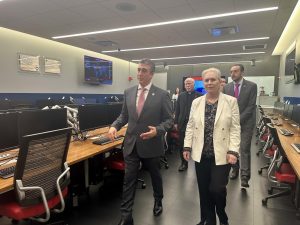Paul Fabozzi, the chair of the Fine Arts department, had two separate galleries showing his work in Philadelphia this past Friday. The shows brought out some 30-plus St. John’s students, faculty, and alumni, along with a large amassing of the Philadelphia art community that come out to the galleries on the first Friday of every month.
The work in both shows comes entirely from 10 walks that Fabozzi took in New York City. They have a definite beginning and a definite end and pieces of data gathered in between those points are used to make large oil on canvas paintings. Gallery Siano displayed six large finished paintings and six works on paper. Just around the corner, at the gallery Carbon 14, Fabozzi broke the layers in the paintings down into specific categories of the original data, each separate and represented in a new visual or sculptural way.
“I make all decisions about the shapes from the photos in literally half an hour,” said Fabozzi on how he decides to layout his paintings. “I figure if I can’t trust my instincts, I’m completely out of luck.”
He relates the process to chance or randomness, same as in his original decision of where to turn in one of his walks. These shapes are then intensely linked together with lines of relation or, as many have called them, “marionette strings.” The layers that are produced create a bold dialogue of representation between shape and vision.
“I don’t know if I like it or not, but it’s interesting. It really catches my eye,” said an art student from a local community college. “From a distance it looks more mathematic, but you walk up closer and the texture comes out.” Many people had the same sentiment: that the work catches the eye and forces you to be contemplative if nothing else.
Catarina Lydon-Warner, gallery director of Carbon 14, said she first saw Fabozzi’s work on InLiquid.com, a non-profit Web site dedicated to promoting artists who work or exhibit in the Philadelphia area. A mainstay of the Philadelphia art community for over 10 years, Lydon-Warner asks artists seeking to exhibit at her gallery to submit proposals on how they would transform the space with their artwork.
“Because the work is site specific, it generates a dialogue between the work and the space and that carries through to create a dialogue between—– the work and the viewer,” she said.
Fabozzi’s work immediately begins that dialogue upon entering the gallery. Viewers first see a large Plexiglas etching consisting of 3,600 lines in various lengths and thicknesses, representing the 3,600 steps taken in the 10 walks. There are rubbings that represent visuals seen every 1/10th of a mile on each walk.
Salt-soaked-paper rust impressions from the laser cut pieces of iron in the shape of each walk. A stainless steel sculpture consisting of every shape from the walks that were then used in the paintings and a piece that visualizes the time spent on each walk down to the second. A handmade accordion book in the middle of the gallery is what Fabozzi calls the “legend.” Said Fabozzi of the relationship between this work and the paintings, “All of the language is in the paintings.”
“There are all these elements that are involved in pulling off this production and that excitement comes through the work,” said Lydon-Warner of the process of an artist preparing to exhibit at Carbon 14. Similarly for Fabozzi, it was not the opening that was important to him, but the process of “making it and getting it to this point.”
The work at Carbon 14 allows one to go back to view the paintings once again with a more educated eye, a different lens-an understanding of the data and how it becomes layered within the paintings.

















